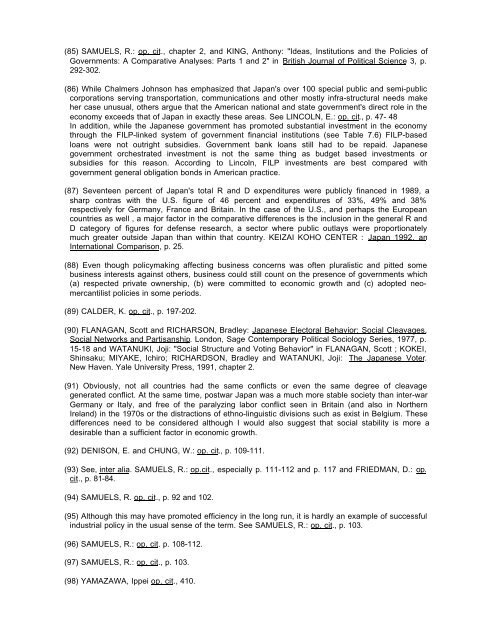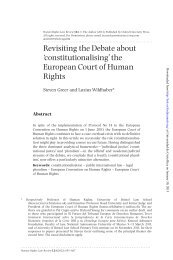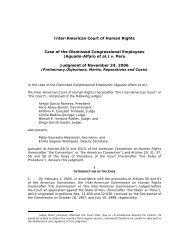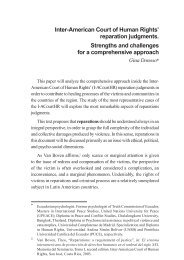The Political Economy of Japan Bradley M. RICHARDSON
The Political Economy of Japan Bradley M. RICHARDSON
The Political Economy of Japan Bradley M. RICHARDSON
- No tags were found...
You also want an ePaper? Increase the reach of your titles
YUMPU automatically turns print PDFs into web optimized ePapers that Google loves.
(85) SAMUELS, R.: op. cit., chapter 2, and KING, Anthony: "Ideas, Institutions and the Policies <strong>of</strong>Governments: A Comparative Analyses: Parts 1 and 2" in British Journal <strong>of</strong> <strong>Political</strong> Science 3, p.292-302.(86) While Chalmers Johnson has emphasized that <strong>Japan</strong>'s over 100 special public and semi-publiccorporations serving transportation, communications and other mostly infra-structural needs makeher case unusual, others argue that the American national and state government's direct role in theeconomy exceeds that <strong>of</strong> <strong>Japan</strong> in exactly these areas. See LINCOLN, E.: op. cit., p. 47- 48In addition, while the <strong>Japan</strong>ese government has promoted substantial investment in the economythrough the FILP-linked system <strong>of</strong> government financial institutions (see Table 7.6) FILP-basedloans were not outright subsidies. Government bank loans still had to be repaid. <strong>Japan</strong>esegovernment orchestrated investment is not the same thing as budget based investments orsubsidies for this reason. According to Lincoln, FILP investments are best compared withgovernment general obligation bonds in American practice.(87) Seventeen percent <strong>of</strong> <strong>Japan</strong>'s total R and D expenditures were publicly financed in 1989, asharp contras with the U.S. figure <strong>of</strong> 46 percent and expenditures <strong>of</strong> 33%, 49% and 38%respectively for Germany, France and Britain. In the case <strong>of</strong> the U.S., and perhaps the Europeancountries as well , a major factor in the comparative differences is the inclusion in the general R andD category <strong>of</strong> figures for defense research, a sector where public outlays were proportionatelymuch greater outside <strong>Japan</strong> than within that country. KEIZAI KOHO CENTER : <strong>Japan</strong> 1992, anInternational Comparison, p. 25.(88) Even though policymaking affecting business concerns was <strong>of</strong>ten pluralistic and pitted somebusiness interests against others, business could still count on the presence <strong>of</strong> governments which(a) respected private ownership, (b) were committed to economic growth and (c) adopted neomercantilistpolicies in some periods.(89) CALDER, K. op. cit., p. 197-202.(90) FLANAGAN, Scott and RICHARSON, <strong>Bradley</strong>: <strong>Japan</strong>ese Electoral Behavior: Social Cleavages,Social Networks and Partisanship. London, Sage Contemporary <strong>Political</strong> Sociology Series, 1977, p.15-18 and WATANUKI, Joji: "Social Structure and Voting Behavior" in FLANAGAN, Scott ; KOKEI,Shinsaku; MIYAKE, Ichiro; <strong>RICHARDSON</strong>, <strong>Bradley</strong> and WATANUKI, Joji: <strong>The</strong> <strong>Japan</strong>ese Voter.New Haven. Yale University Press, 1991, chapter 2.(91) Obviously, not all countries had the same conflicts or even the same degree <strong>of</strong> cleavagegenerated conflict. At the same time, postwar <strong>Japan</strong> was a much more stable society than inter-warGermany or Italy, and free <strong>of</strong> the paralyzing labor conflict seen in Britain (and also in NorthernIreland) in the 1970s or the distractions <strong>of</strong> ethno-linguistic divisions such as exist in Belgium. <strong>The</strong>sedifferences need to be considered although I would also suggest that social stability is more adesirable than a sufficient factor in economic growth.(92) DENISON, E. and CHUNG, W.: op. cit., p. 109-111.(93) See, inter alia. SAMUELS, R.: op.cit., especially p. 111-112 and p. 117 and FRIEDMAN, D.: op.cit., p. 81-84.(94) SAMUELS, R. op, cit., p. 92 and 102.(95) Although this may have promoted efficiency in the long run, it is hardly an example <strong>of</strong> successfulindustrial policy in the usual sense <strong>of</strong> the term. See SAMUELS, R.: op. cit., p. 103.(96) SAMUELS, R.: op, cit. p. 108-112.(97) SAMUELS, R.: op, cit., p. 103.(98) YAMAZAWA, Ippei op. cit., 410.
















